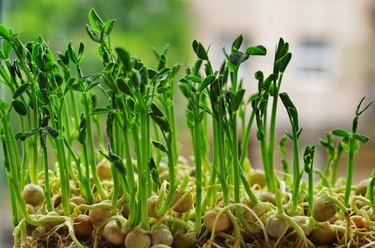
Peas (Pisum sativum) are easy-to-grow vegetables that thrive in the cool days of spring. Green peas must be planted early while the soil is cool, to ensure germinating vs non-germinating seeds. In general, by the time the weather warms enough to plant other vegetables, these annual vines have germinated, flowered and produced their seeds, known as peas, in pods.
About the Peas
Video of the Day
Peas are divided into three main types: shelling, snap and snow. The familiar green peas, also known as English or garden peas, are all shelling peas. Harvest the pods when the peas are plump and rounded and remove the seeds by "shelling" or opening the pod and running your finger down the row of peas to pop them out into a bowl.
Video of the Day
Snap or sugar snap peas are enjoyed when the pods are still young and flat or allowed to grow larger, then harvested and "snapped" like a green bean (Phaseolus vulgaris). Serve young snap pea pods in salads or stir fries, or steam the larger snapped pods and peas until tender.
Snow peas are grown specifically for the flat pods and their tiny seeds. Remove the strings along the edges of the pods and eat raw and dipped in your favorite condiment or sauté lightly for use in stir fries and other Asian dishes.
Germinating Versus Non-Germinating
Pea seed germination depends on soil temperatures. Plant your peas when you are able to work the soil in spring or in fall when the weather begins to cool for a winter crop. While peas will germinate in soil temperatures between 40 and 70 degrees Fahrenheit, the time needed for seedlings to appear will vary. At 41 degrees, it may take up to 36 days, while at 85 degrees, the seeds should sprout in six days. If soil temperatures are near freezing or above 85 degrees, the seeds are unlikely to germinate.
Prepare pea seeds for planting by sorting the seeds. Pre-germinate seeds that are more than 3 years old by soaking, then placing in a folded, moistened paper towel inside a clear plastic bag. Carefully transplant the germinated seeds when roots appear. Discard hollowed, mildewed or otherwise damaged seeds. Soak the seeds overnight in lukewarm water to facilitate quick germination.
Preparing the Garden Bed
Select a sunny or partial shade location in a well-drained garden where peas and other members of the bean family have not been grown for four years. Dig in 2 to 4 inches of compost to a depth of 6 to 8 inches. Alternately, prepare 8-inch-wide or larger containers by filling with an all-purpose potting mix.
Moisten the soil, then plant the pea seeds 1 to 2 inches deep and 2 to 3 inches apart. Space rows at 18 to 24 inches. Install a trellis; otherwise the vines will sprawl across the garden, which makes the foliage, flowers and fruits vulnerable to pests and diseases. Even the shorter vines of the bush-type cultivars benefit from a small trellis to keep the vines elevated for better air circulation.
Keep the soil evenly moist. Use a soaker hose or hose-end bubbler to keep moisture off the vines. When planting early in the spring, the seedlings can tolerate a light frost, but protect flowering and fruiting vines from freezing temperatures.
Non-Germinating Pea Seeds
Even when doing everything right, sometimes pea seeds don't germinate. If the soil became too dry, wet, cold or hot, even for a very short period, the seeds may not germinate. Monitor soil moisture closely to prevent dried out or waterlogged soil and seeds. Cover the rows with row covers to protect against cold. Add mulch around the rows when freezes or hot temperatures are in the forecast to mitigate the effects on the pea seeds.
Other factors in non-germinating seeds include pests, diseases and acidic soils. Wireworms in the soil may infest and eat the seeds before they can germinate. Fungal infections may result in damping off, or the seedlings wilting and dying before they have a chance to grow. If the soil pH is lower than 6.0, the pea seeds may not germinate, as the acidic soil inhibits pea plant growth.